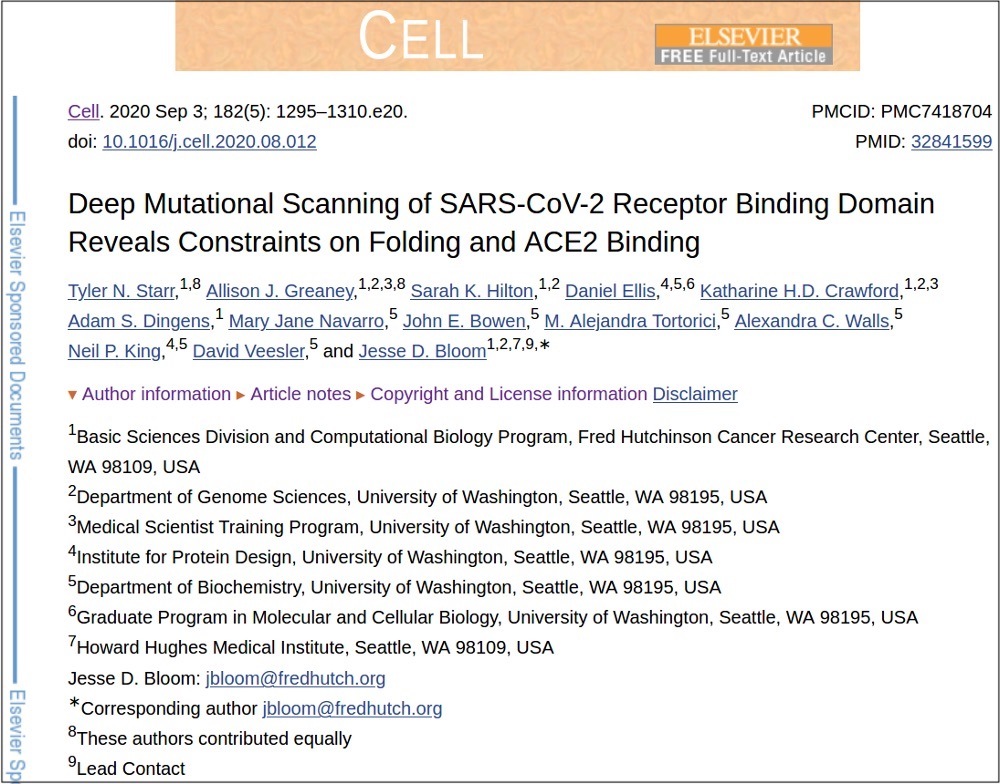(Rosemary Frei) According to What We Hear from Officials and the Mainstream Media, the New Variants Are the Most Dangerous and Unpredictable Beings since Osama Bin Laden.
by Rosemary Frei, February 18th, 2021
Everyone needs to stay safe from these invisible but murderously mighty microbes by shunning contact with the unwashed, unmasked and unvaccinated.
But is that drastic approach — which is accompanied by severe curtailment of civil liberties and constitutional rights — warranted?
It turns out that the case for the variants’ contagiousness and dangerousness centres largely on the theoretical effects of just one change said to stem from a mutation in the virus’s genes.
And, as I’ll show in this article, that case is very shaky.
I also have an accompanying nine-minute ‘explainer’ video, below:
That one change is known as N501Y — scientific shorthand for the substitution of one protein building block (amino acid) for another at position 501 in the part of the virus called the spike protein.
Specifically, position 501 lies in the portion of the spike protein that’s responsible for the intimate coupling between the virus and cells that lets the virus slip inside and multiply.
[Note that any such amino-acid switcheroo is correctly called a change, not a mutation. Mutations occur only in genes. For some reason many scientists and scribes who ought to know better are mistakenly calling N501Y and other amino-acid changes ‘mutations.’ ]
A very preliminary study published Dec. 22, 2020, suggested that N501Y also is present in the South African variant named 501Y.V2. And another very preliminary study, published January 12, 2021, asserted it was also present in the new strain emerging from the Brazilian jungle, dubbed P.1.
On top of that, the South African variant is being reported as evading immunity and B.1.1.7 sharing this escape route. And scientists are depicting new variants with N501Y on board as spreading very fast. Some say they make herd immunity impossible, so every single person on earth has to be vaccinated. The models also suggest B.1.1.7 is up to 91% deadlier than the regular novel coronavirus.
(Yet so far it seems the main basis for officials saying it’s more deadly is shown in the minutes of the Jan. 21, 2021 meeting of an influential UK committee called New and Emerging Respiratory Virus Threats Advisory Group [NERVTAG ]. There, they cite modeling papers which haven’t yet been published – which means that until they’re published there’s no way to check their work.)
THREE NON-PEER-REVIEWED THEORETICAL-MODELING PAPERS WHICH CATAPULTED VARIANTS INTO THE SPOTLIGHT
Public-health officials, politicians and the mainstream media around the world turned their collective headlights on the variants right after the publication of three theoretical-modeling papers on B.1.1.7, a variant originating in the U.K. The first was a Technical Briefing by Public Health England published Dec. 21 (it’s the first of an ongoing series of reports on the variant authored by people working at the agency and at other institutions), the second a paper published Dec. 23 by a mathematical-modeling group at the London School of Hygiene and Tropical Medicine, and the third a theoretical-modeling manuscript posted Dec. 31 by a large group of UK scientists.
None of the three papers was checked over for accuracy by objective observers – a process called ‘peer review.’ Nonetheless, all three were portrayed as solid science by many scientists, politicians, public-health officials and the press.
(I reached out for comment to Public Health England, as well as to the first author of the second paper Nicholas Davies, and to the London School of Hygiene and Tropical Medicine. The only reply I received was from a media-relations person at Public Health England; she told me no one was available for an interview.)
(Neil Ferguson was a co-author of the first and third papers. The UK government has relied on Ferguson’s mathematical modeling for many years. This is despite his work turning out to be highly inaccurate time after time. He also supposedly stepped down from his government-advisory role last May after being caught secretly meeting with his married lover during a time when it was illegal to make contact with anyone outside of one’s household, thanks in large part to his modelling. But he was quickly restored to positions of influence. In an article and accompanying video coming out next week, I describe the connections and conflicts of interest surrounding Ferguson and the modeling papers’ other authors.)
WHAT EFFECT IS N501Y SAID TO HAVE?
In N501Y, the amino acid that’s swapped out at position 501 in the spike protein is asparagine; by scientific convention it’s represented by the letter ‘N.’ The amino acid that’s swapped in in its place is tyrosine, and it’s represented by the letter ‘Y.’ Hence ‘N501Y.’
Position 501 in the amino-acid sequence sits in the part of the spike protein that protrudes from the surface of the virus. Specifically, it’s said to lie in the region of the spike protein that latches or ‘binds’ to the mechanism that is the gatekeeper for whether the virus can enter the cell. That gate-keeping mechanism is known as the ‘ACE2 receptor.’
This region of the spike protein – known as the ‘receptor binding domain’ (RBD) — binds to the gate keeping mechanism, the ACE2 receptor. When the RBD and the ACE2 receptor bind, the cell membrane, which is the circular barrier between the area outside the cell and the cell contents, opens up and allows the virus to enter.
N501Y is posited to make the spike protein bind tighter to the ACE2 receptor. Influential theoreticians have performed mathematical modeling based on this hypothesis. This modeling suggests that this tighter binding allows the virus to enter more easily, and that therefore this makes the virus more transmissible.
Yet as far as I’ve been able to find, there is still no concrete, direct proof of this. And note that epidemiological data cannot be used to definitively detect the effect of an amino-acid in a virus. Only experiments involving direct observation of the virus’s interaction with the body can determine that.
The main evidence that the top three theoretical-models cite as proof of stronger bonding between the N501Y form of the novel coronavirus and the RBD is from just three scientific manuscripts, and these describe experiments with the virus in mice or petri dishes, not observation of whether in fact the variants are truly more contagious or more deadly.
DETAILS OF THE THREE PAPERS THAT UNDERPIN THE ASSERTION THAT N501Y BOLSTERS CONTAGIOUSNESS
One of those three papers was published Sept. 25, 2020, in Science. It describe experiments involving involving six rounds of division of the virus in mice.
The researchers found a large amount of the virus in the mice lungs right from the first round of division. Based on this, they pronounced the virus to have “enhanced infectivity.” However, they didn’t actually test whether the virus is more transmissible/contagious – that is, whether it moves from mouse to mouse more easily.
They performed ‘deep sequencing’ and reported that they found the N501Y change in the ‘mouse-adapted’ virus. Next they did ‘structural remodeling’ on it and wrote that this analysis…
suggested that the N501Y substitution in the RBD of SARS-CoV[-2] S protein increased the binding affinity of the protein to mouse ACE2.
All of this is very different than direct observations of the variant virus’s behaviour in mice or humans.
The second paper was posted on bioRχiv on Dec. 21, 2020. It describes an “engineered decoy receptor for SARS-CoV-2.” The complicated series of molecular-biological manoeuvers in vitro were performed that is hard to follow and understand – there is no ‘Methods’ section laying out the details and sequence of what they did; rather, the researchers’ approach to their experiments is scattered across all sections of the paper including in the accompanying Supplementary Material. This is many steps removed from real-life situations. The authors conclude from their manoeuvers that laboratory-mutated novel coronavirus with the N501Y mutation seems to bind more tightly to their ‘engineered decoy’ form of the RBD receptor than the RBD receptor that normally occurs in nature. (The idea, it seems, is that this ‘engineered decoy’ could be injected into people with the goal of getting the new variant to bind to it rather than to cells, thereby stopping it from gaining entry into cells and reproducing.)
bioRχiv is an online-only journal. (It’s pronounced ‘bioarchive’; that’s because the Greek letter χ is pronounced ‘kai.’ I presume the letter χ is used in the journal’s title because the χ2 [‘chi-square’] test is a widely used form of statistical analysis in scientific papers.) The journal has the tagline ‘The Preprint Server for Biology.’ ‘Preprint’ means non-peer-reviewed. bioRχiv focuses entirely on Covid-19-papers and is sponsored by the Chan Zuckerberg Initiative. It has a sister publication medRχiv that also focuses on Covid-19,
The Initiative is the creation of Facebook head Mark Zuckerberg and his wife Priscilla Chan. Facebook has been among the very active censors of information including scientific papers that diverge from the official narrative about Covid.
The third paper was posted on the website of the online journal bioRχiv on June 17, 2020, and then in Cell on Sept. 3, 2020.
Like the other two papers, it is extremely removed from direct observation of the virus’s behaviour in live animals or humans. In fact, the third paper doesn’t even use human or animal cells. It involves a ‘yeast-surface-display platform’ as a basis for performing ‘deep mutational scanning’ of the novel coronavirus’s RBD. That ‘platform’ is an artificial structure the paper’s authors constructed for measuring binding between antibodies and various RBD regions containing an array of mutations.
According to this paper, the N501Y amino-acid change results in stronger binding of the virus to the RBD.
However, the papers’ authors state in the last section of their paper that:
It is important to remember that our maps define biochemical phenotypes of the RBD, not how these phenotypes relate to viral fitness. There are many complexities in the relationship between biochemical phenotypes of yeast-displayed RBD and viral fitness.
Translation: “Just because our biochemistry experiments showed that the presence of N501Y or other changes in the RBD seems to make the RBD bind tighter to the ACE2 receptor, we don’t know whether any of these changes make the virus more ‘fit’/transmissible.”
And note also that one of the authors of the third paper, Allison Greaney, is quoted as saying in an August 2020 article from the Fred Hutchison Cancer Research Center where she and several of the other authors work, that:
The virus already has a ‘good enough’ ability to bind to ACE2. There’s no reason to believe that going beyond that level will make it more pathogenic or transmissible…[b]ut the RBD may be able to tolerate a number of mutations.
As another note, the third paper was first published in bioRχiv and then published three months later in the peer-reviewed journal Cell. In Cell the paper is labelled ‘Elsevier-Sponsored Documents’ (see image below) (Elsevier is the publishing empire that owns Cell, among hundreds of other journals). I couldn’t find anything online about what ‘Sponsored’ means, nor about what or who sponsored this particular paper; and I couldn’t find any other papers with this designation. So I emailed Cell’s PR manager John Caputo on the evening of Jan. 18 and followed up by leaving him a voicemail message on Jan. 19. I haven’t heard back from him.

‘Deep Mutational Scanning of SARS-CoV-2 Receptor Binding Domain Reveals Constraints on Folding and ACE2 Binding’ (Tyler N. Starr et al.)
A BRIEF WORD ABOUT ANOTHER AMINO-ACID CHANGE IN B.1.1.7
I’ll quickly turn to another of the key changes said to be present in B.1.1.7. This change, the deletion of three amino acids was described in a paper published on the website of medRχiv on November 13, 2020. (Earlier in this article I mention that medRχiv is a creation of the Chan Zuckerberg Initiative.)
The mutation purportedly makes B.1.1.7 invisible to one of the three key functions of the polymerase chain reaction (PCR) test. That function is detection of the gene that has the genetic code for one of the two main spike proteins on the outer surface of the novel coronavirus.
However, that conclusion is based on only sequencing of the virus in a mere six people who tested positive for the novel coronavirus. On top of that, the paper was not subjected to scrutiny by other scientists (a process known as ‘peer review’) before it was published.
In addition, the Covid diagnoses of those six people were themselves determined by PCR. And PCR has been shown to have a very high rate of false positives — that is, to very frequently give a positive result in people who in fact do not harbour the novel coronavirus at all.
The authors of that paper themselves conclude that:
this result should be interpreted with caution. As a limited number of samples with the S-negative profile [i.e., tests that were positive for two of the three portions of the PCR test but not for the third, S-gene, portion] were sequenced, we could not exclude the presence of other S mutations associated with this profile…. Moreover we could not determine whether the deletion affected the primer or other probe-binding region as their coordinates were not available.
It’s a good bet that similar sleights of hand are behind the new wave of papers and headlines focusing on the amino-acid change dubbed E484K.
WHAT’S THE LESSON FROM ALL THIS?
That the pronouncements about the dire danger posed by the new variants aren’t based on solid science.
They appear to be aimed more at scaring the public into submitting to harsher and longer restrictions than helping to create truly evidence-based policies.
So follow the golden rules. Read the primary scientific-paper sources. Analyze them and think for yourself. Don’t let your reasoning be swept away by the 24-7, fear-filled news cycle.
About The Author
After obtaining an MSc in molecular biology from the Faculty of Medicine at the University of Calgary, Rosemary Frei pivoted and became a freelance writer. That led to 22 years as writer and journalist focusing on medicine. She pivoted again in early 2016 to full-time, independent activism and investigative journalism. Her website is RosemaryFrei.ca.
Stillness in the Storm Editor: Why did we post this?
The news is important to all people because it is where we come to know new things about the world, which leads to the development of more life goals that lead to life wisdom. The news also serves as a social connection tool, as we tend to relate to those who know about and believe the things we do. With the power of an open truth-seeking mind in hand, the individual can grow wise and the collective can prosper.
– Justin
Not sure how to make sense of this? Want to learn how to discern like a pro? Read this essential guide to discernment, analysis of claims, and understanding the truth in a world of deception: 4 Key Steps of Discernment – Advanced Truth-Seeking Tools.
Stillness in the Storm Editor’s note: Did you find a spelling error or grammatical mistake? Send an email to [email protected], with the error and suggested correction, along with the headline and url. Do you think this article needs an update? Or do you just have some feedback? Send us an email at [email protected]. Thank you for reading.
Source:
https://healthimpactnews.com/2021/the-shaky-science-behind-the-deadly-new-strains-of-sars-cov-2/


Leave a Reply